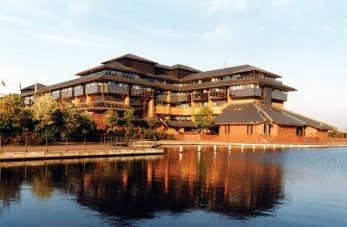Approval given for council core office proposals to move to the next stage

Cardiff Council’s Cabinet has accepted the recommendations in a report exploring the options for the local authority’s long term office requirement.
Proposals under consideration could see City Hall benefit from a multi-million-pound investment to address ongoing maintenance requirements to secure the heritage venue for future generations.
An Outline Business Case commissioned by Cardiff Council has looked at several options to better align the local authority’s office space with business need and energy efficiency and carbon standards. The key consideration for the Council is whether to refurbish the existing County Hall building or build a new, smaller office building.
The report indicates that a new building would be substantially cheaper, while the difference in terms of carbon impact is likely to be marginal. The assumptions set out in the Outline Business Case will be tested in detail through a Full Business Case as the next stage in the process.
Cardiff Council currently has three core office sites: City Hall; County Hall and Willcox House. The report to Cabinet also confirms the current phasing out of Willcox House, with the lease for it coming to an end in March 2024, now that it is surplus to the Council’s requirements.
The business case found that, following the move to hybrid working, Cardiff Council requires 140,000 square feet of core office space. The existing County Hall has 277,000 square feet of office space. The next stage will determine the long-term use of City Hall, and the size and cost of delivering a new, smaller County Hall.

In 2021, a report projected the cost to remain in City Hall and County Hall in their current format, considering maintenance and the improvements required for decarbonization, was around £140m, or £180m today, after inflation and the additional work required since the report was published, are factored in.
Commenting on the rationale behind the proposals, Cabinet Member for Cabinet Member for Investment & Development, Cllr Russell Goodway, said: “As the owner of City Hall, a Grade I Listed Building, Cardiff Council has a duty to invest in the fabric of the building, as well as renewing its mechanicals and electricals, such as heating and ventilation, so that it remains fit for purpose as a heritage venue of historical significance, both now and for future generations.
“County Hall, our other core office building, is too big for what the Council now needs, so to keep that level of accommodation would be unsustainable, especially at a time when budgets are extremely tight. Not only that, if we were to continue with County Hall as it is, tens of millions of pounds would need to be spent on maintenance, and to bring it up to a standard to meet future legislation and carbon commitments and given its form of construction the long-term life span of the building would be limited.
“There is not much Grade A office stock available in Cardiff, and the office space that is available would require significant spending to bring it up to standard, on top of the multi-million-pound purchase price.
“Partial demolition or the potential to rent out the surplus office space of County Hall were both considered as part of the review, but the costs associated with any retention far outweighs building new.”
Although a new County Hall could be built on several sites in Cardiff, the current Atlantic Wharf location is the preferred option.
Cllr Goodway added: “Atlantic Wharf as the site of a new County Hall brings a number of advantages. It is already an established Council HQ location that works. It is a site owned by the Council, which brings a significant cost saving. The new building would be part of the Atlantic Wharf development plan, bringing inward investment to support wider regeneration of the area, and assisting other projects, including the arena and the Red Dragon Centre redevelopment. There are already good transport links to Cardiff Bay, which would be enhanced by the development of the Metro. The new building could be constructed whilst the Council continues to occupy the current building, avoiding the need for a costly relocation of staff to a temporary location.”
Following the Cabinet approval, the next steps are to develop a Full Business Case for the Council’s core offices. This will need to happen before any final decision is made.
Cardiff Council’s Cabinet met on Thursday, June 22to consider the recommendations contained in the report, and a webcast recording of that meeting is available to watch here.
Prior to the Cabinet meeting, the report was scrutinised by the Policy Review and Performance Committee when it met on Tuesday, June 20. A recording of that meeting is available to view here.
A copy of the full report can be read here.
One Planet Cardiff is the Council’s vision of a carbon neutral Cardiff by 2030. The One Planet Cardiff Strategy can be read here.